I like to think of myself as a bit of an aficionado of walking tours. I did spend a year as a full-time traveller, and now live as a weekend tourist in one of the greatest cities in the world, so I really have trod more than my share of miles attempting to keep up with tour guides from Belfast to Beijing. But last week I did a walk like no other, run by a company called Unseen Tours. Their guides do not hold the coveted blue badge sported by so many professional tour guides in London. In fact, Unseen Tour guides aren't professionals at all. That's because Unseen Tours are guided by people who have an unusual perspective on the city, because they're homeless, or recently homeless, or "vulnerably housed."
I can't remember how I heard about Unseen Tours, though it was likely from one of the many emails, RSS feeds or other Random Interesting London Things (RILTs) that filter through my consciousness more or less continuously. (Unsurprisingly, the volume of RILTs available to anyone even remotely switched on is frankly staggering.) The tours grew out of the activities of a group called The Sock Mob, a grass roots outreach program of volunteers who take to the streets regularly to meet, talk to and befriend homeless people around London. Their icebreaker is that they give out fresh pairs of socks, an understandably valuable commodity for people with no sock drawer of their own. The tours are seen as a way of helping people to understand the homeless as something more than a vaguely scary or distasteful presence on the fringes of society. As one of the founders of the Sock Mob says, the point of the tours is to give the homeless a bit more "ownership" of their lives and to "present [homeless people] in a very different light so that people can see them as having something to offer." (There's some good information about the nitty gritty of the tours here.)
Most of the £10 fee for the tours stays with the individual guides, who are coached for months by Sock Mob volunteers before being deemed ready to guide the general public. There are currently five different tours offered, at London Bridge, Shoreditch, Covent Garden, Brick Lane and Brixton. Even though the Brixton tour was right in my back yard, I decided to head to Covent Garden. Maybe because it's easy to have a tourism-driven, romanticised "Eliza Doolittle" idea of the area, I thought that learning about it from such a different perspective would be really interesting. And I wasn't wrong.
It was a cold day last Sunday. Not Winnipeg cold, but damp and chilly enough that I elected to wear long underwear and a toque and a lot of layers. It was the kind of day that made it clear what a brutal thing it must be to sleep rough through a London winter. My tour started at Temple tube station, tucked in along the Embankment at Waterloo Bridge. I showed up a few minutes early and found my guide, Viv, who's originally from Norway, but has been a Londoner since 1975. Maybe it was because it was a cold and rainy day, or maybe because the tube station was closed, but whatever the reason I was the only one who'd shown up for the tour that day. Viv didn't seem bothered by this, so she took my £10 and we set out on my personal guided tour of unseen areas around Covent Garden.
We started in the small gated park right next to the station, and Viv gave me an unexpectedly scholarly rundown of the history of the name "Temple" which is apparently derives from the knights Templar, they of the crusades. (She's something of an expert on the Crusades). These days the nearby Middle and Inner Temples are two of the four Inns of Court, which are the professional associations for barristers in England and Wales. Then, in the kind of left turn that would soon became familiar, she pointed over to one of the wooden benches in the park and said, "I used to sleep there." Needless to say, this is not the kind of comment I've ever had from a tour guide before.
It was these kind of things that made the tour for me. Viv was really open about her past, and talked about when she and her partner were part of a small community of people who slept in that park in Temple in 1999. Apparently it's a coveted spot (not least because a charity hands out food across the street every night). There are benches to get you up off the ground, and its completely fenced in so once the gates are locked at night there's a measure of safety that's not available in more open areas. She even told me about a set-up she had that involved borrowing crates from a nearby fruit and vegetable stall outside the tube station and setting them up like a mattress, covered in layers of newspaper, with a sleeping bag and a tarp over top. It was, relatively speaking, a good arrangement, though also a lot of work because the crates had to be returned to the stall before the stall-holder arrived in the morning, and the other bits had to be dismantled and hidden in the park during the day so the cleaners wouldn't toss them out. Anyone who believes the homeless are lazy might have a think about the effort involved in keeping body and soul together with no fixed address.
Viv says there are about 4,000 people who sleep rough in London every night, though that number goes up in the summer. And I suppose its not surprising to learn that the homeless community is, well, just that: a community. People tend to know each other, or know of each other. Small groups like Viv's gang in the park at Temple form and stick together for a time, regulating who is and who isn't let in, based on word of mouth and personal recommendations. When she was sleeping in that park, Viv knew each person on the other benches.
After the park, we moved off past one of the few remaining cab shelters in London. These distinctive tiny green huts were established to provide a place for the drivers of hansom cabs (and later motorised taxis) to shelter from bad weather and get a bit of hot food and drink. They were run as a benevolent service founded by the Earl of Shaftesbury in 1875 and intended, at least in part, to keep the drivers out of the pubs while on duty. At their height there were 61 shelters in London; 13 still survive and continue to serve food and drink.
As we moved along under Waterloo Bridge, we came to another important spot in the homeless geography of the area. The areas under bridges are generally popular because they're sheltered but publicly accessible, and this spot in particular was another of Viv's former homes. She'd had a "bash" on a platform area under Waterloo Bridge. As she explained, a "bash" is a temporary shelter made from found materials - tarps, tents, cardboard, shipping pallets, whatever. Having a bash is quite good, though even then you still have to be careful of theft and random violence. Viv talked about having to haul her bedding around all day to stop it getting nicked, which again shows that life on the streets requires a lot of effort.
Beyond her stories of homeless life, Viv really was a source of tons of proper tour-guide-like information. If I tried to tell it all you'd be here all day and your coffee would definitely get cold. I got the history of Somerset House, a peek down an alley of King's College that contains an 2,000 year old Roman Bath mentioned in "David Copperfield", and an excellent anecdote about the Savoy Hotel. But really, the most interesting bits were the little insights into the world of rough sleeping in central London, and about Viv's personal experiences. For instance, I've had a pint or two at this pub on the Strand:
For Viv, The Coal Hole was once a regular haunt where she met an actor who was in a show at one of the nearby theatres. He used to sit at the tall tables outside and was friendly and chatty, often giving her a bit of money if he had some spare in his pocket. Only later did she find out her benefactor was Richard Harris, the actor who may be best-remembered as Dumbledore in the first two Harry Potter movies.
Eventually we made our way to Covent Garden Market, the tourist hot spot. Along the way Viv pointed out the people sleeping in doorways and explained they do that because its safer to sleep during the day so you can be awake and aware at night when it's most dangerous. The hours after the pubs close are particularly fraught and the homeless are often targets of verbal and physical abuse for drunk revellers. It's not unheard of for people to be kicked or spat on, and there have been cases of people being doused in lighter fluid with attempts made to set them alight. I'll say it again: it's a tough life. There's also violence within the homeless community. Alcoholism can be common, and wherever alcohol is abused (whether it's in a touristy Covent Garden pub or in a bash under Waterloo Bridge) hostility and violence often follow.
Covent Garden had a particularly personal landmark for Viv - the place she slept when she first became homeless. Near the Transport Museum there are several outdoor staircases that lead directly into the basements of the museum and surrounding buildings. I'd never noticed them before but one of them, in front of the newly-opened fancy "Balthazar" restaurant, was Viv's former haunt. In a particularly odd moment we found ourselves at the top of the gated stairs as a young woman arrived on her way down to what's now the staff entrance to the restaurant. Viv chirpily informed the girl that she used to sleep under these stairs, fifteen years ago. The girl's reply was to ask - and I'm not kidding - "This place was here fifteen years ago?" It was bizarre. How can someone living in London and possessing of even an iota of awareness of their surroundings estimate the age of a building in Covent Garden is younger than several shirts I own?
We then took a chilly wander past the Dickens Coffee House and the Theatre Royal Drury Lane. There's an interesting ghost there, one of the many who are said to inhabit this "most haunted" theatre in the West End. "The Man in Grey", as he's known, is supposedly only seen on the opening nights of shows that go on to a successful run, making him perhaps the most popular poltergeist in London.
Eventually we ended up at a spot that turns out to be a landmark for homeless Londoners. Lincoln's Inn Fields is the largest public square in London. Wikipedia notes that it was privately owned until 1895, but Viv's version of events is different. She told me that an old woman used to own the square, and bequeathed it to the homeless when she died. Local solicitor's firms launched a legal appeal about the bequest that was eventually upheld on the technicality that "the homeless" as a general group (as opposed to a particular, named, homeless person) were not eligible to inherit. "You won't find this on Google" said Viv, and indeed she's right. A few minutes online reveal nothing of Viv's version of events, but certainly its true that there was a large homeless community at Lincoln's Inn Fields in the 1980s. They were eventually cleared out in 1992, and fences were erected around the square and locked every night, but Lincoln's Inn Fields remains one of the only places in London where the homeless are fed every day of the year. I leave it to you to decide whose version you want to believe.
The tour ended at the square. By this time my fingers were stiff with cold and my feet were sore and I wanted nothing so much as a warm cup of coffee and a place to sit and thaw out. The Unseen Tours website suggests that patrons might want to invite their tour guides for a cup of coffee or a pint after the tour, I suppose to continue fostering personal relationships among the housed and the unhoused and to reduce the stigma associated with being homeless. I was getting ready to ask Viv if she wanted to join me for a cuppa (she really did have a lot of interesting stuff to say, I sensed she could have gone on for another two hours) but before I could offer she said she was off to catch a bus and was gone, leaving me to make my way to the tube and then back to my warm and friendly home in Brixton. I never asked Viv if she's still living on the street. Despite all the personal details she shared it seemed like it would be rude to pry about her current circumstances. So while I was safely tucked up with a cup of tea and my toes under a blanket in my room, I don't know where Viv ended up. But I do know she opened my eyes a little bit to a world that's always been on the periphery, and I'm glad she got my ten quid.
The homemade sign marking the start point of an Unseen Tour.
Most of the £10 fee for the tours stays with the individual guides, who are coached for months by Sock Mob volunteers before being deemed ready to guide the general public. There are currently five different tours offered, at London Bridge, Shoreditch, Covent Garden, Brick Lane and Brixton. Even though the Brixton tour was right in my back yard, I decided to head to Covent Garden. Maybe because it's easy to have a tourism-driven, romanticised "Eliza Doolittle" idea of the area, I thought that learning about it from such a different perspective would be really interesting. And I wasn't wrong.
It was a cold day last Sunday. Not Winnipeg cold, but damp and chilly enough that I elected to wear long underwear and a toque and a lot of layers. It was the kind of day that made it clear what a brutal thing it must be to sleep rough through a London winter. My tour started at Temple tube station, tucked in along the Embankment at Waterloo Bridge. I showed up a few minutes early and found my guide, Viv, who's originally from Norway, but has been a Londoner since 1975. Maybe it was because it was a cold and rainy day, or maybe because the tube station was closed, but whatever the reason I was the only one who'd shown up for the tour that day. Viv didn't seem bothered by this, so she took my £10 and we set out on my personal guided tour of unseen areas around Covent Garden.
We started in the small gated park right next to the station, and Viv gave me an unexpectedly scholarly rundown of the history of the name "Temple" which is apparently derives from the knights Templar, they of the crusades. (She's something of an expert on the Crusades). These days the nearby Middle and Inner Temples are two of the four Inns of Court, which are the professional associations for barristers in England and Wales. Then, in the kind of left turn that would soon became familiar, she pointed over to one of the wooden benches in the park and said, "I used to sleep there." Needless to say, this is not the kind of comment I've ever had from a tour guide before.
The Park. (Note to RobH: I would have taken a picture of Vic, but she specifically asked me not to post photos of her because of her personal situation. She was fine about sharing details in person, but understandably didn't want them broadcast online alongside her photo.)
Viv says there are about 4,000 people who sleep rough in London every night, though that number goes up in the summer. And I suppose its not surprising to learn that the homeless community is, well, just that: a community. People tend to know each other, or know of each other. Small groups like Viv's gang in the park at Temple form and stick together for a time, regulating who is and who isn't let in, based on word of mouth and personal recommendations. When she was sleeping in that park, Viv knew each person on the other benches.
After the park, we moved off past one of the few remaining cab shelters in London. These distinctive tiny green huts were established to provide a place for the drivers of hansom cabs (and later motorised taxis) to shelter from bad weather and get a bit of hot food and drink. They were run as a benevolent service founded by the Earl of Shaftesbury in 1875 and intended, at least in part, to keep the drivers out of the pubs while on duty. At their height there were 61 shelters in London; 13 still survive and continue to serve food and drink.
The cab shelter at Temple Place. Anyone can buy food from the stall, but the small number of seats inside are still reserved for cabbies only. Viv says you can get a cup of tea for 70 or 80p and a bacon roll for two quid. Not bad.
You can just see that someone's got a tent set up on the platform. Apparently there even used to be a water tap, which was, as you can imagine, very helpful.
The Coal Hole. They do a decent ploughman's lunch.
Eventually we made our way to Covent Garden Market, the tourist hot spot. Along the way Viv pointed out the people sleeping in doorways and explained they do that because its safer to sleep during the day so you can be awake and aware at night when it's most dangerous. The hours after the pubs close are particularly fraught and the homeless are often targets of verbal and physical abuse for drunk revellers. It's not unheard of for people to be kicked or spat on, and there have been cases of people being doused in lighter fluid with attempts made to set them alight. I'll say it again: it's a tough life. There's also violence within the homeless community. Alcoholism can be common, and wherever alcohol is abused (whether it's in a touristy Covent Garden pub or in a bash under Waterloo Bridge) hostility and violence often follow.
Covent Garden had a particularly personal landmark for Viv - the place she slept when she first became homeless. Near the Transport Museum there are several outdoor staircases that lead directly into the basements of the museum and surrounding buildings. I'd never noticed them before but one of them, in front of the newly-opened fancy "Balthazar" restaurant, was Viv's former haunt. In a particularly odd moment we found ourselves at the top of the gated stairs as a young woman arrived on her way down to what's now the staff entrance to the restaurant. Viv chirpily informed the girl that she used to sleep under these stairs, fifteen years ago. The girl's reply was to ask - and I'm not kidding - "This place was here fifteen years ago?" It was bizarre. How can someone living in London and possessing of even an iota of awareness of their surroundings estimate the age of a building in Covent Garden is younger than several shirts I own?
This is what most people think of when they think "Covent Garden". Spin around 180 degrees from this view and you'll see this:
This kind of staircase used to be able to shelter 12-24 people every night, tucked out of the way, under cover, sometimes even near warm air vents. Relative luxury.
Now they're inaccessible - walled off or fenced or locked up.
Now they're inaccessible - walled off or fenced or locked up.
This is the Stage Door side of the Theatre Royal Drury Lane. Apparently these columns were salvaged from a stretch of Regent Street between Piccadilly Circus and Oxford Circus. They were removed because they were a popular spot for prostitutes plying their trade. Some were relocated to Drury Lane, the assumption presumably being that anywhere with such a high concentration of theatres and actors must already be beyond hope. (Unrelated aside that I have to throw in because it makes me feel cool: I've worked there! At the theatre, of course. NOT up against the columns.)
We also walked past this place, which I had no idea was there.
The gazebo now at the centre of Lincoln's Inn Fields.
The tour ended at the square. By this time my fingers were stiff with cold and my feet were sore and I wanted nothing so much as a warm cup of coffee and a place to sit and thaw out. The Unseen Tours website suggests that patrons might want to invite their tour guides for a cup of coffee or a pint after the tour, I suppose to continue fostering personal relationships among the housed and the unhoused and to reduce the stigma associated with being homeless. I was getting ready to ask Viv if she wanted to join me for a cuppa (she really did have a lot of interesting stuff to say, I sensed she could have gone on for another two hours) but before I could offer she said she was off to catch a bus and was gone, leaving me to make my way to the tube and then back to my warm and friendly home in Brixton. I never asked Viv if she's still living on the street. Despite all the personal details she shared it seemed like it would be rude to pry about her current circumstances. So while I was safely tucked up with a cup of tea and my toes under a blanket in my room, I don't know where Viv ended up. But I do know she opened my eyes a little bit to a world that's always been on the periphery, and I'm glad she got my ten quid.




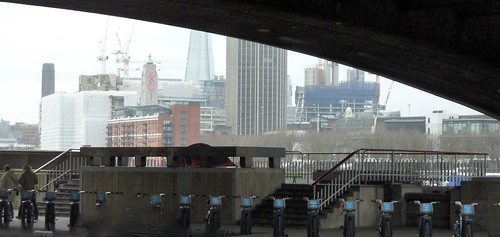
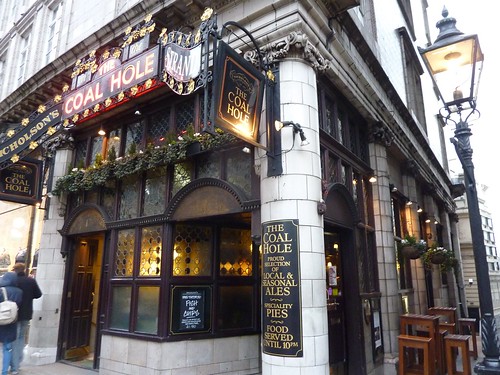

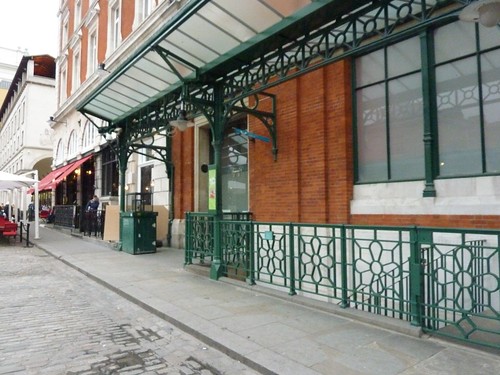
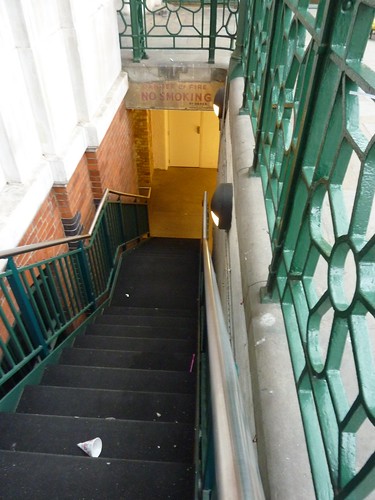
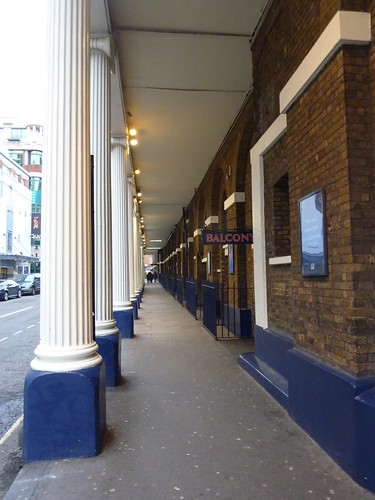
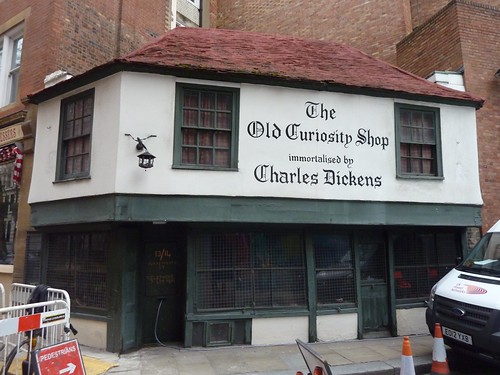
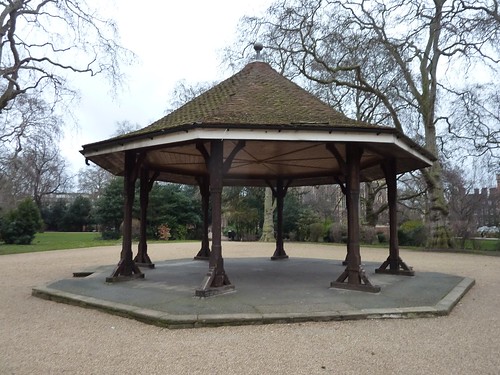


2 Comments:
No pic of Viv, granted, but that is no excuse for no pic of you.
This is going in my report...
Where and when are we meeting for dinnerus maximus this year?
Rob H.
What a brilliant tour! Kudos to the Sock Mob and to Viv your valiant tour guide (as well as the other Unseen Tour guides). Thanks for sharing!
Post a Comment